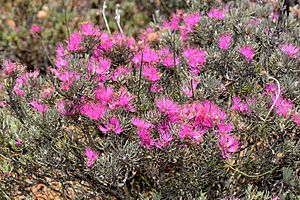Melaleuca aspalathoides facts for kids
Quick facts for kids Melaleuca aspalathoides |
|
|---|---|
 |
|
| Melaleuca aspalathoides growing near Mundaring | |
| Scientific classification | |
| Genus: |
Melaleuca
|
| Species: |
aspalathoides
|
Melaleuca aspalathoides is a cool little shrub. It belongs to the myrtle family, called Myrtaceae. You can only find this plant in a small part of Western Australia, in the south-west. It's a small bush with soft, grey leaves. Its bright magenta flowers have special parts called calyx lobes around them.
Contents
What Does It Look Like?
This plant, Melaleuca aspalathoides, usually grows to be less than 60 cm (20 in) tall. That's about as high as your knee! Its leaves are shaped like thin cylinders. They are about 7–28 mm (0.3–1 in) long. The leaves grow close together on the stem. They are covered with soft, grey-green hairs, making them feel silky.
New leaves that grow on fresh shoots are often longer and softer. They are also silkier than the older leaves on the plant.
Flowers and Fruit
Bright magenta-coloured flowers appear on the plant in late spring and summer. These colourful flowers grow at the ends of the branches. They stand out nicely against the plant's grey leaves. The bottom part of each flower is woolly. The five sepals (leaf-like parts) around the flower are very pointy.
After the flowers bloom, the plant produces fruit. These fruits are round or shaped like an urn. They are about 7 mm (0.3 in) long and 5 mm (0.2 in) wide.
Plant Names: Taxonomy
This plant was first officially described in 1844. A scientist named Johannes Conrad Schauer wrote about it in a book called Plantae Preissianae. He studied a plant sample found near York in 1840.
The second part of its scientific name, aspalathoides, means it looks similar to plants in the genus Aspalathus.
Where Does It Grow?
You can find this type of melaleuca in Western Australia. It grows in an area between Walkaway, Western Australia and the Brookton-Tammin areas. These areas are part of special natural zones called biogeographic regions. These include the Avon Wheatbelt, Geraldton Sandplains, and Jarrah Forest.
The plant likes to grow in loam (a type of rich soil) on gravelly ridges.
Is It Protected?
The Government of Western Australia's Department of Parks and Wildlife has looked at Melaleuca aspalathoides. They have classified it as "not threatened." This means it is not currently in danger of disappearing.

